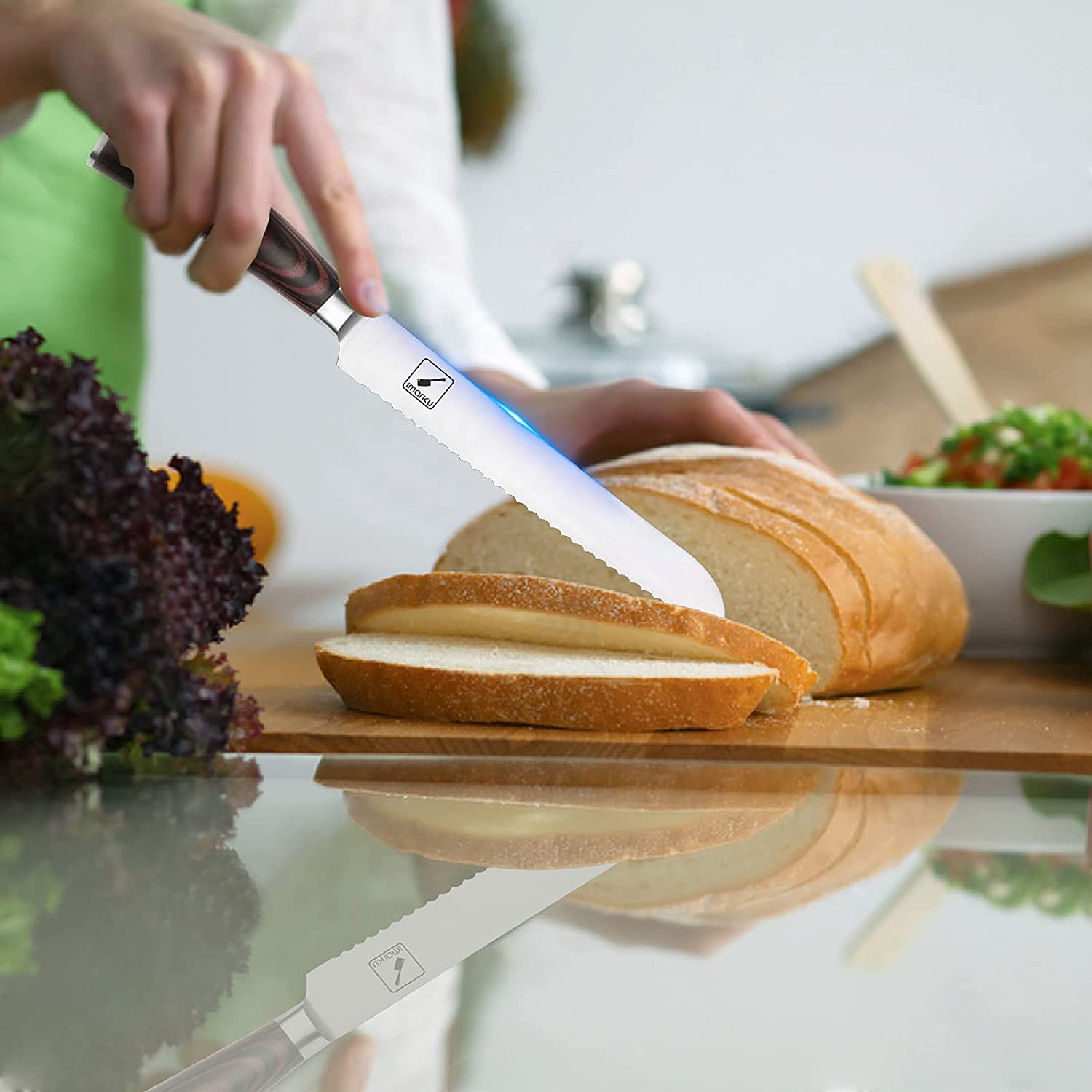TABLE OF CONTENTS
A bread knife is almost a culinary staple since it can perform a host of functions despite its name limiting it to the single use of cutting bread. And the key to this high-class performance is its serrated edge.
Quite contrary to the smooth and straightened edge of a chef's knife, a bread knife uses a toothy serration all through the length of the cutting edge. This functions like a saw and helps in slicing the bread or some other ingredient as you move the knife in a rocking motion using downward pressure that you would have to do with other kitchen blades with a plain edge.
How important is a good bread knife?

If you invest in the best bread knife, it will handle around two to three jobs. They are crucial, so a home chef cannot imagine a life without them. Firstly, it can help slice a fresh and crusty loaf of bread. And if you want to place a thin slice of tomato on the top of a bread slice, the bread knife will come to your rescue again.
Though dedicated cake knives are available, you may also use them to cut the cake into several layers. Then you can spread each layer with frosting and reassemble them.
Actually, a serrated bread knife can help you slice through mangoes, avocados, delicate pastries, and a lot more. These knives are pretty useful because of the tiny grooves or notches that allow the kitchen blade to slice through the crusty outer covering without destroying the insides. There are two sizes available: 10 inch and 8 inch bread knife.
What is a bread knife used for?

The name itself suggests what a bread knife is used for. But the good news is that it can serve not limited to one kind of bread. You can use it for cutting all kinds of bread from brioche to pita to baguettes and everything in between, including biscuits and cakes.
Large fruits and vegetables are also a great match for cutting with a bread knife. For instance, melons, squash, and other large fruits can be difficult with straight-edged blades, but a bread knife can cut it effortlessly.
How to care for a bread knife?
Caring for your kitchen blade starts from understanding what a bread knife used for and using it accordingly is. When you cut bread, make sure you opt for a sliding motion and in a single direction only.
To protect the blade from damage, you should always use a chopping board made of plastic or wood. If you want to scrape off bread from the board, you must use the knife's spine in place of the blade.
Also, it's better to hand wash the knife using soap and warm water. You shouldn't use a dishwasher as your bread knife may get warped or banged. Then wipe down with a clean towel from the spine to the sharp side and also the handle. You shouldn't allow it to air dry to avoid rust formation.
Besides, you should store the knife by applying a thin layer of mineral oil with a soft cloth. This will prevent corrosion or oxidation of the high-carbon stainless steel when exposed to high moisture content. You should also store your bread knife in a dry place away from other utensils so that it doesn't become dented or scratched. You may also hang it on a magnetic board for maximum protection.
How to sharpen a bread knife?

Sharpening a bread knife is quite a tricky task. The most promising means of sharpening your bread knife is using a sharpening rod. It will let you sharpen each tooth seamlessly. For this, you should opt for a sharpening rod with a diameter matching the blade's serrations. If your sharpening rod is very thick, it will not fit into the serrations, and sharpening will be of no use. But if it is extremely thin, then you may get worked up to strike the entire serration.
If you like to sharpen your bread knife yourself, be sure to care about the specifications because they are different by brand.
To sharpen the bread knife, you should lay the rod in the serrations, moving it upward and downward. You should watch your knife closely and check each tooth while sharpening. If required, you will have to hold the rod at a slanting angle. It's better that you lay the bread knife on the edge of a flat surface to avoid accidents and get even sharpening.
Moreover, when you are sharpening the serrations of one side, you will notice a burr emerging on one side. This can be easily removed if you move your bread knife a bit slanting.
Although it seems easy, it needs the practice to get better results and may destroy your favorite one. So the best solution is to leave it up to the professionals. You can search for local knife sharpening services to get the sharpest result.
Conclusion
The shape of a bread knife blade is not meant to represent an aesthetic design. They are designed ergonomically. Keep in mind the requirements of cutting through loaves of bread and fruits or veggies with hard rinds. If you notice that the edge of your bread knife has started to show dullness, you should take measures to sharpen it. Last but not the least, every premium kitchen knife deserves care and maintenance, and your bread knife is not exceptional to this.






















Leave a comment
All comments are moderated before being published.
This site is protected by hCaptcha and the hCaptcha Privacy Policy and Terms of Service apply.